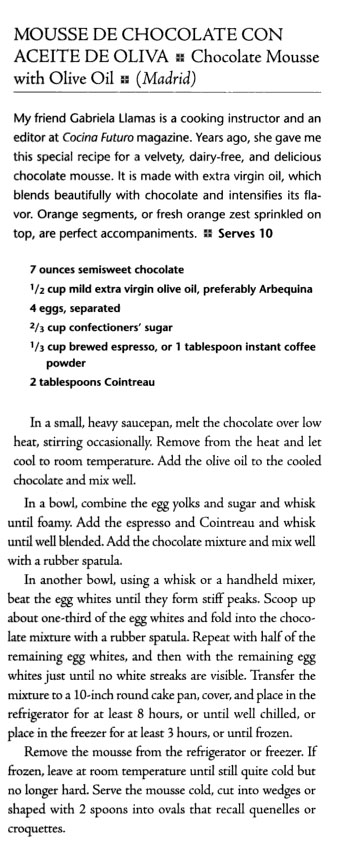
Horchata De Cufas
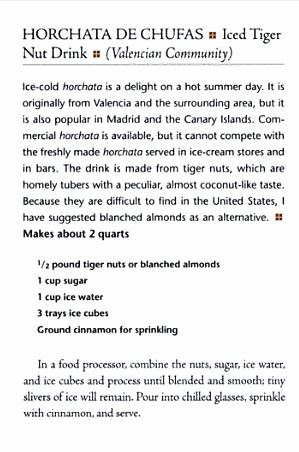
Horchata De Almendra - Almond Horchata
As Tiger nuts are difficult to souce, here is an alternative using almonds
1/2 kg Almonds
1/2 kg Sugar
1 Lemon
1 Cinnamon Stick
1 Pinch of Salt
2.5 litres Water, warm
First the skin of the almonds must be removed, the easiest way to do this is to boil them. Put the almonds into a pan of boiling water and leave them until the skins become soft and removeable
Grind the almonds into a coarse powder. If you boiled your almonds to get the skins off, they can be blended.
In a large bowl/container add the 2.5 litres of water and the pinch of salt. Add the sliced lemons.
Mix in the ground almonds and cover the container leaving it at room temperature for about 2 hours.
After two hours add the sugar and cinnamon stick and stir until sugar is completely dissovled.
Strain the liquid with a fine sieve or cloth to remove all of the larger bits of almond then strain until it is smooth in texture, this may need doing two or three times to remove all the bits.
Keep the drink in your fridge and it will stay good for at least five days.
Crema Catalana (Catalan Cream)
Because of its crisp, caramelized topping, this creamy Catalan dessert is
often compared to the French creme brulee. Sweet Catalan cream, however, is
not as heavy or rich as its French cousin.
From: S.Mancini@t-online.de (S.Mancini)
Source: Cooking in Spain by Janet Mendel-Searl. 6 Portionen
6 egg yolks
200 g sugar
3/4 l milk
lemon peel
cinnamon stick
1/2 c milk
3 tb cornstarch
Beat the egg yolks and 150 g sugar in a bowl. Put the 3/4 l milk in a saucepan with the cinnamon and lemon peel and bring it to a boil. Remove from fire and strain it into the eggs, whisking them constantly. Dissolve the cornstarch in the half-cup of milk and stir it into the custard mixture. Pour the mixture into the saucepan and cook it on a low heat, stirring constantly, just until it starts to bubble. Remove from the heat and strain into a shallow pudding bowl. Let the custard cool. Before serving, sprinkle the top with remaining sugar and caramelize it with a hot salamander (or use a metal spatula or small iron frying pan, heated red hot) or place under a broiler. Decorate the pudding with biscuits or squares of cake and rosettes of whipped cream.
Jose Pizarro slices a fig into quarters almost all the way through and places it on top of the dessert, then sprinkles everything with sugar and caramalises it.
Tocinillo de cielo (Heaven's little pig)
Tocinillo de cielo is one of the most surprising desserts of the Spanish gastronomy. Created in the early years of the last century, when wineries from Jerez de la Frontera donated the leftover egg yolks of the clarification (the egg whites are used to clarify the wine) to the nuns. These, with divine success, mixed them with syrup and they treated to the bath Maria, thus was born tocinillo de cielo... God blesses them!
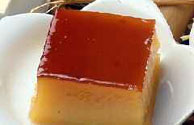 6 egg yolks
6 egg yolks
9 oz sugar
1 fl.
oz water
For the caramel:
3 tablespoons sugar
1 tablespoons water
Put the sugar in a saucepan with the water and heat until the syrup goes golden brown. Cover a baking tin evenly and put to one side. Put the sugar and water in an earthenware dish and heat until the syrup goes stringy. Beat the egg yolks and slowly add the syrup, stirring with sticks. Strain and pour into the caramelised tin. Cook in bain-marie in the oven at 150º for around 20 minutes. When the tocino has set, remove from the oven, leave to cool and take it out of the tin.
Leche Frita (Fried milk)
Leche frita (fried milk) is a traditional Spanish dessert recipe. It's quite
easy to do, and the results are spectacular. Serves 4
32 fl.
oz milk
6 fl. oz olive oil
1 spoonful of sunflower oil
2 eggs
2
oz corn flour
2 oz of light flour
1 stick of cinnamon
4 oz sugar
Dilute the flour together with the corn flour and sugar in 1/4l of milk. Boil the rest of the milk with the cinnamon stick for ten minutes and add it, after straining, into the paste made earlier.
Simmer the mixture on a low heat, without stopping stirring, for a period of 10 minutes. Put it on a tray greased with sunflower oil and allow it to cool.
Once the mixture is cold, cut it into rectangles of about 10 x 5cm, putting them into flour and beaten egg and frying them on a medium heat in the 2dl of olive oil. Dry off the excess oil and sprinkle them with sugar and ground cinnamon.
Flan (Caramel Custard)
This is the classic flan, which is as light and delicious as it is timeless.
This basic flan recipe is also used to make flans of different flavors by
substituting another liquid for part or all of the milk. For example, the best
sweet oranges in Spain come from Valencia and Murcia, and an orange flan, made
from freshly squeezed juice, is popular there.
Because flan takes a while to cool, it is usually prepared early in the morning or on the previous evening. When making it for a large group, it's practical to prepare a single large flan in a 5 by 9-inch mold and slice it for serving, rather than use individual cups.
From: S.Mancini@t-online.de (S.Mancini)
Source: Cooking in Spain by Janet Mendel-Searl. 4 Portions
175g sugar
1/2l milk
cinnamon and lemon peel or vanilla
2 egg yolks
2 whole eggs
Spread the sugar evenly in the bottom of a heavy saucepan and place over medium-low heat. It may take several minutes before the sugar begins to melt. Without stirring, watch the sugar closely as it begins to liquefy at the edges. All of it will slowly turn first into a yellowish and then golden syrup and finally into a brown caramel sauce. Remove from heat and pour the liquid caramel into 4 custard cups and tilt to cover the bottom and sides evenly. It is important to do this transfer quickly, as the change in temperature causes the caramel to solidify rapidly. Set aside.
Scald the milk with the cinnamon and lemon peel or vanilla. Beat the egg yolks and whole eggs until mixed and beat in remaining sugar. Whisk in the hot milk, then pour the custard through a sieve into the mold or molds. Set them in a pan and add hot water to half their depth. Put in a medium oven until the custard is set, about 40 mins. Cool the custards, run the knife around the inside of each cup to loosen the edges of the custard and then invert the flan onto a dessert plate.
Goxua (Creme Basque)
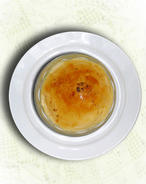 1/4 litre milk
1/4 litre milk
1 oz cornflour
1 oz sugar
lemon peel
1 stick of
cinnamon 20 grms butter
vanilla
1 egg yolk
1/4litre whipped cream
80 g of sponge cake (or magdalenas)
rum
liquid caramel
To make the pastry cream:
Heat the milk leaving aside 1 glass.
Add
the sugar, vanilla, lemon peel and the cinnamon stick.
Mix the cornflour
with the remaining milk.
When the milk comes to boiling point add in the
cornflour mixture. Stirring constantly for 2 minutes making sure the mixture
does not become lumpy.
Remove for the heat and add in the egg yolk and
butter. Mix well and leave to cool.
To prepare the dessert:
In small individual clay dishes place a layer of
whipped cream, then place a layer of sponge cake soaked in rum on top. Then pour
on a layer of the pastry cream.
Decorate with the liquid caramel and leave
to rest in the fridge for 6 hours.
Serve Cold.
See also here
Magdalenas (Spanish Cakes)
 Magdalenas are small sweet cakes that are rich-tasting, but light and fluffy.
The Spanish traditionally eat them at breakfast with cafe con leche, and they
are said to have originated in Aragon.
Magdalenas are small sweet cakes that are rich-tasting, but light and fluffy.
The Spanish traditionally eat them at breakfast with cafe con leche, and they
are said to have originated in Aragon.
Magdalenas are not often prepared in homes today, but are sold in supermarkets and bakeries everywhere. These little cakes would be a great addition to any breakfast or a Sunday champagne brunch. Makes 18 magdalenas.
4 eggs
1 cup Granulated Sugar
1
4 oz. stick Unsalted Butter
1 2/3 cups Unbleached White Flour
1 Tbsp
Baking Powder
Zest from 1 lemon
1 Tbsp Milk
Preheat the oven to 375 degrees Fahrenheit (200 degrees Centigrade). Measure 1/4 cup sugar into small bowl and set aside. In a medium-size mixing bowl, beat the eggs with 3/4 cup sugar. Beat until the mixture is light. Add Melted Butter and Lemon Zest
In a small sauce pan, melt the butter on medium on the stove top. Or, melt it in the microwave. Make sure that the butter cools slightly and is not bubbling. As you continue to beat the egg mixture, slowly pour in the melted butter, making sure to mix thoroughly. Stir in the lemon zest and milk. Add Dry Ingredients
Measure out the flour into a separate bowl. Add the baking powder to the flour and mix thoroughly.
While stirring the egg mixture, add in the flour mixture. Continue to stir until all ingredients are mixed well. The batter will be very thick. Spoon Batter in to Cupcake Pan
Place paper liners in to cupcake pan. Use a large serving spoon to spoon batter into pan, filling each one half full. Batter will more than double in size when baked. Use a teaspoon to sprinkle each magdalena with a bit of the reserved sugar. Place pans on the middle shelf of the preheated oven for 18-20 minutes, until magdalenas have turned a golden color. Remove from oven and allow to cool for 5 minutes before taking out of the pan to cool further.
Bizcochos Borrachos (Drunken Sponge Cakes)
Light spongy cake, drizzled with a sweet sauce of brandy, lemon andcinnamon.
It is a wonderful light dessert to complete a Spanish dinner. These "bizcochos"
are the perfect accompaniment to a hot cup of Spanish coffee or hot chocolate on
a cold morning or for afternoon tea. Makes 1 8-inch cake or 9 small servings.
4 Eggs
1/2 cup
Granulated Sugar
3/4 cup Flour
1 tsp Baking Powder
1 tsp Ground
Cinnamon for Decoration
For Sauce:
1/3 cup granulated Sugar
8 oz.
Water
1.5 Tbsp Honey
1 1/2 oz. Brandy or Rum
1 Cinnamon Stick
Peel
from 1/2 Lemon
Preheat the oven to 350 degrees Fahrenheit or 180 degrees Centigrade. Generously grease a 8-inch square cake pan with vegetable shortening, then flour it. Separate the yolks from the egg whites. Then, beat the egg yolks in a bowl with the sugar until it forms a creamy mixture.
In another mixing bowl, beat the egg whites until they are stiff enough to form a point. Fold in the yolk mixture with a spatula, smoothly and carefully. Fold in the baking powder and flour gradually, a bit at a time. Pour in the batter and bake for 20 minutes, or until it turns golden. Check doneness by inserting a toothpick into the center. If it is clean when pulled out, cake is done.
While the cake is baking, make the syrup. In a small sauce pan, pour water and sugar, cinnamon, honey and lemon peel. Bring mixture to a boil, stirring occasionally. Allow to boil 1 minute. Remove from heat and add the brandy and allow the syrup to cool.
After the cake has cooled, carefully cut into 9 pieces and place them on a serving plate. Drizzle the pieces of cake with the brandy sauce and then dust the top with cinnamon. Serve with coffee or tea.
Yemas
The original yemas were probably made with a version of dulce de leche which
is a reduced and thickened milk. The milk gets sweeter as it gets more
concentrated. Condensed milk is probably a more modern shortcut for the
recipe.
6 egg yolks
1 (14 oz.) can sweetened condensed milk
1 tsp. lemon
extract
Cinnamon sugar
Combine egg yolks with sweetened condensed milk in a small saucepan. Cook mixture over low heat, stirring constantly for about 30 minutes--until it forms a soft ball when dropped in cold water.
Remove from heat and place saucepan in a bowl of ice water. Beat until mixture is quite stiff. Pour at once into a pan lined with waxed paper. With a rubber spatula, roll up edges to form a long, thin roll. Chill in refrigerator until almost firm.
Cut into 1-inch pieces and roll into small balls the size of marbles. Roll in cinnamon sugar and allow to dry at room temperature.
See also here or here, alternative recipe:
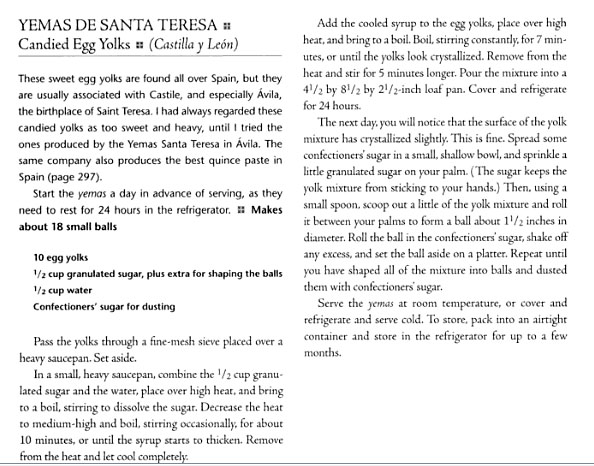
Huesos de santo (Spanish pastry rolls)
12 servings
1 pound almonds
2 ¼ cups
sugar
confectioners' sugar
For the syrup:
½ cup sugar
½ cup
water
For the candied egg yolk filling:
4 tablespoons sugar
5 egg
yolks
Make almond or marzipan paste and spread it on a clean surface powdered with confectioners' sugar. Roll out the dough with a rolling pin (about 0.2 in. thick). Cut into 2.4 inch strips and roll out their surface. Turn strips and roll each twice around a thin wooden stick (separated from one another.)
Assemble rolls by gently gathering their edges with some water and syrup. Pull wooden sticks out. Bake rolls at 150 F. degrees in a pan powdered with sugar until they are mildly dry and hardened. Then, fill them with cabello de angel (Spanish pumpkin filling), candied egg yolk filling and cover them with a basic syrup.
Truchas de Batata o Cabello de Ángel (Yam Truchas)
1 Kg. of yellow yam
3/4 Kg. of sugar
100 grams of peeled
almonds
grated lemon rind
ground cinnamon
3 tablespoonfuls of butter
1 small
cup of olive oil
1/2 Kg. of flour.
1. For the stuffing, cook the yams with water and salt and grind them. Mix in a bowl the grinded yams with the almonds, the sugar, the grated lemon rind and the cinnamon, until they bind into a thick paste. Set it aside.
2. For the puff pastry first shape the flour into a mountain and place the butter and the oil in the centre. Knead it all until it gets thoroughly mixed and leave it to stand.
3. Flour a rolling pin and table and roll the pastry. Make pies of 8cm. of diameter. Put the stuffing in the centre and fold them, making sure that the corners get well bound using a fork.
4. Finally fry the pies in very hot oil until ready to eat.
Another possibility is to make the stuff with sweet pumpkin filling.
Cabello de Ángel (Angel Hair)
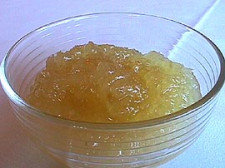
 The combination of squash, lemon rind or cinnamon and sugar
provides the stuffing characteristic in many spanish sweet dishes.
The combination of squash, lemon rind or cinnamon and sugar
provides the stuffing characteristic in many spanish sweet dishes.
• A ripe winter squash
• Sugar
• rind of half orange
• rind of half a lemon
• A cinnamon stick
Peel the pumpkin and carve, removing the seeds. Add the pulp to a pot of water and cook until soft, boiling for about an hour (you will see that is becoming transparent color).
When nearly cold, with the help of a spoon, remove meat from the crust separating the filaments. Set to drain in a strainer and squeeze with your hands to remove any water.
Weigh the pulp and calculate that for every pound of flesh 800 gr. sugar. Put the pulp in a saucepan, add sugar, cinnamon and orange peel and lemon. Cook until the sugar is melted about 10 minutes. Remove and let stand for 24 hours. After this, again cook another 10 minutes more. Allow it to stand for another 24 hours again. Return to cook again another 10 minutes, cool and is ready to consume.
Natillas (Custard Cream)
Natillas is a traditional Spanish dessert and is similar to cold custard, but
creamier and with a hint of cinammon. Most Spanish restaurants offer natillas in
their list of home-made dessert . This is an easy recipe for Spanish natillas
which just takes about 30 minutes.
8 egg yolks
1 litre milk
200 gr. sugar 1 dessert
spoon cornflour
1 stick of cinammon
Powdered cinammon
1. Put the milk in a saucepan with the cinammon stick and heat. Save a small glass of cold milk.
2. Beat the egg yolks with the sugar. Dissolve the cornflour in the cold milk, stir well and then add to the eggs and sugar.
3. When the milk is starting to boil, remove the cinammon stick and add the mixture of flour, milk, eggs and sugar. Stir well over the heat until the custard thickens. Don't boil.
4. Put the natillas into individual bowls or dessert glasses. Sprinkle with a little cinammon powder.
Tips and ideas: Many Spanish cooks add a biscuit to the natillas mixture when they are pouring it into the individual bowls. The biscuit sometimes rises and as the natillas cool, becomes soft. A bit like a Spanish version of stale cake in English trifle. If you want to do this, choose a plain biscuit (the Spanish "Maria" biscuits are what Spanish people use).
Walnut Pudding
by Maria Galdos Landeen. Serves six
1 quart whole milk
1 cup sugar
1 cup walnuts, ground fine
1 cup breadcrumbs, ground fine
The breadcrumbs are optional, however if not used, double the amount of walnuts.
Combine all ingredients in a medium size kettle and bring to a boil over low heat, stirring constantly unitl it thickens. This will scorch if not stirred. pour into serving bowls and chill.
Torrijas (Bread Pudding)
You should definitely try torrijas at Easter. They are eaten all over Spain
and consist of slices of bread soaked in milk, sugar and egg, fried in olive
oil. According to what they are dipped in, and the way they are presented, there
are other, delicious varieties: with wine, syrup, honey or sprinkled with sugar
and cinnamon. Serves: 4
32 fl. oz of milk
olive oil
16 oz. honey
16
oz. sugar
8 eggs
Slices of bread for 'torrijas'
Cut a large loaf of bread for 'torrijas' in fairly thick slices (you can also use special ready sliced bread).Mix the milk and sugar in a deep bowl. Beat the eggs in a separate dish. Dip the slices of bread in the sugared milk and eggs and fry in a pan with boiling oil until golden brown. Then drain well. Place the 'torrijas' on a serving dish and pour honey over them. It is also traditional to add the sugared milk to the serving dish so that the 'torrijas' soak it up and become more spongy.
Chocolate Mousse
